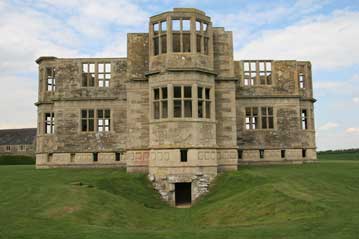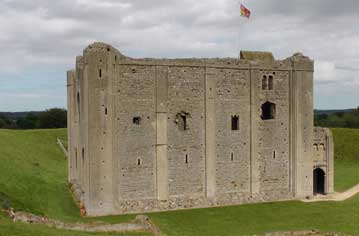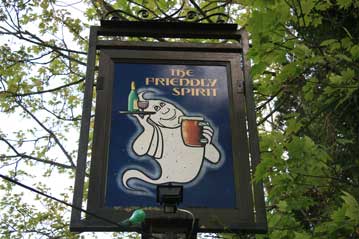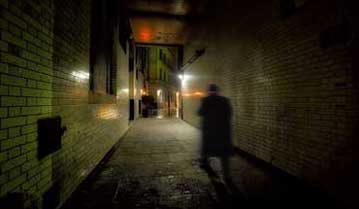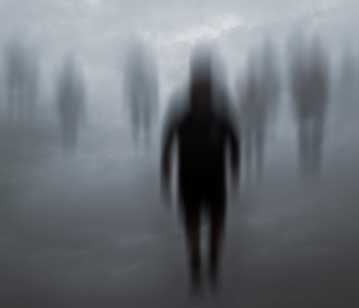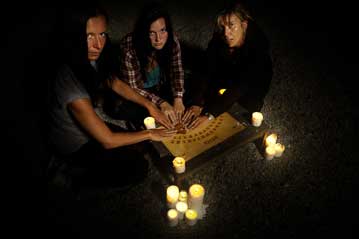HAUNTINGS AND LEGENDS
OF THE NORTH EAST
The region that stretches across the North East of England is, in the minds of many, often associated with an industrial age that has long since passed. It is a region of contrast, and you begin to fall under its spell as you journey through the scenic delights of Yorkshire and on through the enchanting landscapes of County Durham and Tyne and Wear to find your senses assailed by the breathtaking beauty of the untamed Northumberland coast.
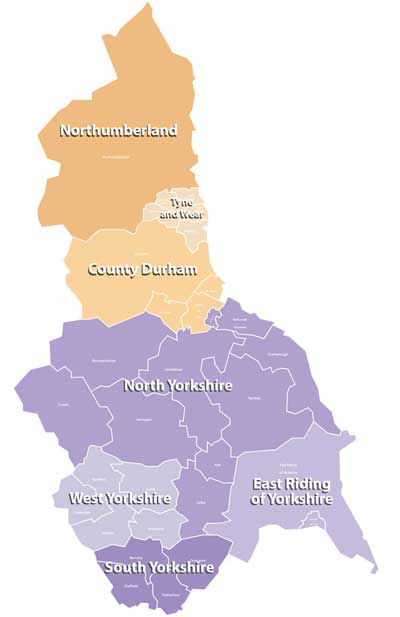
A WILD AND UNTAMED FRONTIER
In the past, however, this was a wild frontier land that was the lawless domain of savage cattle stealers and ruthless warlords.
In the 8th century, Viking raiders brought terror to the ancient Kingdom of Northumbria, on the North West coast. As they moved inland, and began to settle, they brought with them tales of dragons, ogres, trolls and demon hounds, and supplanted these fearsome creatures into the dark places that Celtic legend had already imbued with an evil reputation.
Their descendants would become the cattle stealers and ferocious warlords who ravaged and pillaged the Scottish borderlands throughout the Middle Ages.
The memories of these unsettled times still linger in the gaunt ruins of the sturdy towers and castles that litter the region, and in the ghosts that may be encountered among them. For this wild and wind-rattled region, with its abundance of haunted, mystical and mysterious locations, makes a fitting backcloth against which to set some truly chilling and thrilling ghostly tales.
GHOST STORIES FROM THE NORTH EAST
Winter's Gibbet
Steng Cross
In 1791 the body of William Winter was hung here in chains within sight of the place where he had murdered old Margaret Crozier.
The present gibbet stands on the exact spot where stood the old gibbet the stone at its foot is the base of a Saxon cross which marked the highest point of this ancient drove road down which cattle were driven from Scotland to the English markets.
Eerily positioned on a bleak the bleak and lonely Elsdon Moor surrounded by the purples and greens of the turf and Heather. A creaking chain swings back and forth high over your head contains and wooden replica of a human head which swings eerily back and forth swayed by even the faintest murmur of a breeze.
The wild and lonely moor that surrounds this sinister place is the haunt of "The Brown Man of the Moors."
An 18th century tale tells of two young men who were hunting on this inhospitable and fearsome moor land. Having lunched one of the two went to dink from a nearby stream but on raising his head from the cool babbling waters was surprised to see a dwarf staring at him "…his head covered with frizzled red hair, his countenance ferocious and his eyes glowing like those of a bull.."
The stoutly built little man began to scold the youth for hunting the creatures that he claimed were his subjects and told him in no uncertain terms that he was trespassing on his land.
The hunter apologised profusely whereupon the apparition told him that he was the protector of all the creatures who dwelt upon the fell and it was his solemn duty to punish anyone who hurt them. He invited the youth to come home and dine with him informing him that he was a vegetarian.
The youth accepted the invitation but suddenly his companion shouted to him, causing him to turn away fro a brief second. When he looked back the little man had disappeared and he and his friend continued hunting returning home with much game.
He would, however, have done well to have heeded the apparitions warning for that very night he took ill and within a few days was dead.
But to this day many who find themselves wandering the bleak moors report catching fleeting glimpses of a red – headed spectre patrolling the high moors gazing upon them with a ferocious eye and malicious intent.
Trollers Gill
Nr Appletreewick, North Yorkshire
The foaming brown river waters, that cascade through this dark ravine, appear to be making a desperate attempt to flee the unfettered evil that seems to ooze from every pore of its sheer rock walls.
Trees sprout from tiny crevices or cling desperately to the unrelenting slopes. Dark caves yawn, mysterious and forbidding, almost daring you to step beyond their jagged jaws and confront whatever malevolent forces might be lurking within.
Legend says that trolls live deep inside their icy depths. Dull witted, hairy cannibals with stinking breath and huge noses, which help them sniff out the blood of their human prey.
At night they leave their cavernous vaults to patrol the gill, attacking lone wayfarers, exchanging human babies for their own hideous offspring and indulging in a good deal of petty theft.
But worse still is the spectre of the "Barguest," a hideous, demon dog with long black hair and flaming eyes.
His dreaded growl chills the blood of those that hear it, and the sound of his paws padding across the cold wet rock, can reduce even the most intrepid wanderer to a nervous, shivering wreck.
In the 19th century, a young man, who sneered at such legends, is said to have entered the Gill one night, intent on capturing and enslaving the beast. His lifeless body was found the next morning, torn and bleeding on a rocky ledge. Massive claw marks gouged deep trenches across his chest, and his face was hideously contorted, its frozen expression of abject terror, a vivid testimony to his last desperate moments, spent gazing helplessly into the fiery eyes of the "Barguest."
Dunstanburgh Castle
Nr. Embleton, Northumberland
Sprawled across a windswept cliff top, against which thunderous waves pound incessantly, the sinister ruins of Dunstanburgh Castle possess an uncanny aura that the proximity of a sea-sprayed golf course, does little to dispel.
Begun in 1316 by Thomas, Earl of Lancaster and enlarged by John of Gaunt, the once proud fortress had, by the 16th century, fallen into decay being described in Henry VIII's reign as "a very ruinous house and of small strength."
It was around this time, occurred the events which have endowed the castle with a ghostly reputation.
Sir Guy the Seeker was a gallant knight who, whilst riding along the Northumberland coast one day, found himself caught in a dreadful storm. The lightning flashed above him, the thunder crashed around him, he was blinded by the rain and lashed by the wind. Desperate for shelter, he chanced upon the ruins of Dunstanburgh Castle and, leading his terrified horse up the perilous and twisting rocky path, took sanctuary from the tempest beneath the shattered turrets of its massive gatehouse.
As the storm raged and the wind howled through the crevices of the castle walls, there suddenly appeared a hideous figure dressed in white that urged him to follow to where he would be rewarded by the sight of a "beauty bright."
The fearless knight followed up a narrow winding staircase and into a room where lay a hundred sleeping knights and their horses.
At the centre of the chamber, in a sparkling crystal casket, there slept the most beautiful maiden Sir Guy had ever seen. On either side of her, were two serpents, one holding a sword, the other a horn.
The spectre told the Knight that he could awake the lady, but that he must choose whether to use the sword or the horn. Only the correct choice would rouse her.
He thought for a moment and then, striding forward took up the horn and blew it. Suddenly the sleeping Knights flashed into life and rushed at him, whereupon the bold, brave and fearless Sir Guy fainted clean away.
As the room began to swirl, the figure in white came towards him, a look of contempt upon its twisted features and, as the gallant Knight slipped into unconsciousness he heard its taunting voice, echoing round and round inside his head. "Now shame on the coward who sounded a horn And the knight who sheathed a sword."
When Sir Guy regained consciousness, he was lying beneath the ruins of the gatehouse.
From that day forth he was determined to find the sleeping maid again. It became an obsession as he rummaged about every nook, corner and cranny of the mouldering ruin.
But, no matter how hard he searched, he never again found the room in which she lay, and he died a broken and lonely old man.
But on windswept, storm tossed days as the wild waves thunder against the castle rock and the raging winds howl through the tottering ruins, his ghost is said to wander the stark passages and winding stone staircases, still seeking the "beauty bright" amidst the savage remnants of this imposing edifice.
Chillingham Castle
Chillingham, Northumberland
Chillingham Castle is a dark and foreboding place of twisting, stone stairways, echoing corridors, creepy, dank dungeons and creaking doors.
Its inner courtyard, resplendent with age-blackened faces that gaze down from the torch scarred walls, is surely the most atmospheric of any in England. Its balustrades, pillars, balconies and romantic galleries, could have come straight from the pages of Arthurian legend, and it would come as little surprise if you were to encounter a knight in burnished armour, clanking his way up the sweeping, stone staircase that delivers the spell-bound visitor into the Castle’s sprawling interior.
Chillingham began life as a 12th century stronghold. In 1246 the Grey family stormed it and evicted the then owners, their descendants have remained in possession ever since. Henry 111 stayed here in 1255, as did Edward 1st in 1298- en route to vanquish William Wallace, who was making a decided nuisance of himself north of the border!
Later, Sir Thomas Grey was given permission to fortify the family stronghold, and in 1344, Chillingham became a castle.
Embellished and adorned by successive generations, the last of their descendants (by then the Tankerville's), moved out in 1933, and the proud bastion was allowed to fall into ruin.
An aura of melancholic decay had soon descended upon the once mighty walls, as damp and rot chewed their way through its fabric.
Then, in 1983, Sir Humphrey Wakefield, whose wife is a member of the Grey family, was allowed to take over the decaying ruin, and began a restoration that is still on going today.
Thus was the castle awakened from its long sleep, and thus can visitors now explore, and even stay overnight at, what is, without doubt, one of England's most guest friendly and deliciously eccentric castles, devoid of the pretentious prissiness with which so many ancestral homes are imbued.
Several ghosts are known to wander the castles' eclectic and timeworn interior.
The most famous, is that of the "Radiant Boy," a childish wraith that is seen in the castles' Pink Room, and whose heart-rending cries of either fear or pain, echo through the corridors upon the stroke of midnight.
In the past, the cries always seemed to emanate from a spot close-by where a passage is cut through the ten feet thick wall, into the adjoining tower. As they faded away, a bright halo of light would appear and the figure of young boy, dressed in blue would approach those sleeping in the room.
Later the bones of a child, surrounded by decaying fragments of blue cloth were found behind the wall where the haunting begins. They were given a Christian burial and thereafter, the "Radiant Boy" was seen no more.
Until, that is, Sir Humphrey began letting the room. Some guests complain of a blue flash that shoots out of the wall in the dead of night. Although they attribute it to an electrical fault, Sir Humphrey is quick to point out that there are no electrics in or around that particular section of the wall.
Another unquiet soul to stalk the castle, is the spirit of Lady Berkeley, wife of Lord Grey, whose husband ran off with her own sister, Lady Henrietta and left her alone at the castle, with only their baby daughter for company. The rustle of her dress is sometimes heard as her invisible revenant sweeps along the rambling corridors, searching for her errant husband, and leaving a cold chill, not to mention bemused witnesses, in her ghostly wake.
Bamburgh Castle
Bamburgh, Northumberland
The subtle alchemy of sky and sea that swirl around the huge whinstone crag from which the fairy-tale turrets and lofty battlements of Bamburgh Castle rise, casts a potent spell that reaches far back into the foggy mists of time.
Once the ancient Royal seat of the Kings of Northumbria, it suffered several attacks from the ferocious Norsemen, the final one in 1015 spelling the end of its days of glory.
Rebuilt by the Norman's, its lord, Robert de Mowbray, rebelled against the hated Red King, William 11, and found himself taken prisoner, whilst his wife held the castle.
William brought the manacled de Mowbray within sight of the battlements, and sent word to his lady that, unless she surrendered the castle forthwith, she could watch her husband's eyes being gouged out. Sensibly, she chose to surrender.
Besieged by the Scots during the reign of King Stephen and later bombarded with artillery by the Yorkist in the Wars of the Roses, it was the first castle in England to fall to the power of gunpowder.
Thereafter it became a dilapidated ruin until, in the early 18th century, Lord Crewe, Bishop of Durham, acquired it and, shortly afterwards, it came into the possession of a charity run by Dr John Sharp, the curate of the village who, disturbed by the number of shipwrecks occurring in the treacherous coastal waters hereabouts, established Britain's first life-boat station here.
In 1894, the first Lord Armstrong, whose family still own the castle, purchased it.
Needless to say, with such a rich and varied history, the castle has had ample opportunity to acquire a spectral populace that more than complements its mortal habitation.
Several visitors have felt a spectral tap on the shoulder on the flight of stairs near the library and some have found it so unnerving that they have felt compelled to leave the castle immediately.
Others have seen a misty apparition, which they have unhesitatingly identified as being that of Dr John Sharp.
Inevitably, the castle has also retained the spectral services of that mainstay of all castle ghosts, the female phantom in a coloured dress, which, given that her hue at Bamburgh is pink, has become known as the "Pink Lady."
At some stage in Bamburgh's long and eventful history the flesh and blood incarnation of this forlorn wraith was a Northumbrian Princess whose father, disapproving of the boy his daughter loved, sent the unfortunate suitor overseas for seven years. He made sure that the couple could not exchange messages and, in this way, hoped that his daughter's passion would cool.
But with each day that passed, the poor girl became more and more depressed and, in a last attempt to persuade his simpering off-spring that the boy really was unsuitable, the King told her that his spies had learnt that her intended had married someone else abroad.
Hoping to bring her out of the melancholy that the news induced, the king asked the castle seamstress to make his daughter a fine new dress in her favourite colour - pink.
The distraught girl donned the finished garment and, climbing the stairway to the highest battlements, flung herself into eternity and crashed to her death on the rocks below.
Shortly afterwards her lover returned, unmarried from his exile, and was heartbroken by news of what had happened, although the legend does not record what fate then befell him.
But the Princess returns to the castle every seven years, when her mournful revenant, clothed in a dress of shimmering pink, wanders through the corridors of the oldest section, before gliding down the rocky path that leads to the beach, where she stands upon the pale gold sands, gazing sadly out to sea, forever awaiting the return of her lost love.
Blanchland
Blanchland is one of England's prettiest and least changed villages.
Although most of the houses date from the 18th century, they are laid out on the foundations of Blanchland Abbey to whose plan the village remains true and, consequently, has an almost Mediterranean feel.
The Abbey struggled on in its remote and lonely setting from its foundation by the Premonstratension order in 1165 to its dissolution by Henry V111 in 1536.
It was the distinctive white woollen habits worn by the order that gave the village its name "Blancalande" or "White Land."
A church stands at one end of the tiny village and in its churchyard there is reputedly a mass grave where lie interred the mortal remains of monks slaughtered in the course of a particularly savage raid by the "border reivers."
The story goes that a raiding party of these feared and ferocious outlaws set out intending to pillage and plunder the Abbey.
As they followed an old drovers track the monks received warning of their approach and readied themselves as best they could for what seemed certain death and destruction.
But no sooner had the raiders crossed over nearby Hexamshire Common than a heavy fog suddenly descended upon them and becoming disorientated they lost their way.
Seeing the hand of God behind the miraculous fog that blanketed the valley the monks began ringing their bells in joyous thanks.
Unfortunately their would-be attackers also heard the peal and used their sound to locate the Abbey where they massacred the monks.
From that Day forth its is often said that on certain days of the year the church bells will chime out a mournful knell tolled by unseen hands and that the misty figures of the murdered monks are seen around the churchyard.
The Lord Crewe Arms, Blanchland
Formerly the Abbot's guesthouse and kitchen of Blanchland Abbey the Lord Crewe Arms is surely one of England's cosiest and most atmospheric hotels.
Its barrel vaulted crypt bar, massive stone fireplaces (one of which contains a cleverly concealed "Priest's Hide"), ancient, stone walls and low beams positively crackle with the memories of the events it has witnessed not to mention the shimmering shades of those behind many of the events.
Many buildings of such impressive antiquity are able to advertise a haunted room. The Lord Crewe arms can boast three.
Its best known, and most famous ghost, is that of Dorothy Forster whose brother, Tom, found himself the reluctant commander of the Jacobite forces during the 1715 uprising. With no qualifications and even fewer natural instincts for such a post, he surrendered to the government army at Preston without even attempting to put up a fight.
Taken to London he was imprisoned in Newgate Prison where, with Dorothy's assistance, he managed to escape three days before he was due to stand trial for High Treason.
They returned to the Lord Crewe Arms where he was hidden in the fireplaces "Priest's Hole" before being smuggled to safety in France.
Although Tom died in France, Dorothy has remained at the Lord Crewe Arms ever since haunting the Bamburgh room and urging those she may choose to manifest before to take a message to her brother in France that all is now well and it is safe for him to return to England.
In the Radcliffe room in the late 1990's an American lady staying in the Radcliffe room who knew nothing of the buildings connections with the Abbey and even less about the white habits worn by the monks, woke during the night to see a monk in a white habit kneeling at the bottom of her four poster bed. She reached across and touched him finding him to be "quite solid" but then watched in amazement as he slowly melted away before her very eyes.
Some years ago a local lady, whose house had been flooded and who was well acquainted with both the hotel and its staff, was forced to spend a winters night in the here, where she was the only guest. In the early hours, she was woken by the sound of the outside door being opened and closed. She heard heavy footsteps and saw a light, flickering beneath her door. Moments later the footsteps grew fainter and the light was extinguished.
Next morning she told the manager that she had heard "Old Tom" moving around the hotel lighting the fires, only to be told that too had in fact died several months before. When they checked the outside door they found it locked and bolted and no living person could have entered that part of the hotel overnight.
Aydon Castle
Situated in a remote wilderness, the dark stone corridors of this 14th century castle has borne witness to several tragic events.
It is a still, strange place of darkness and shadows where in the 1930s two children from the family who then lived here are said to have been killed in a fire.
As you ascend the steps by the kitchen range a pressing feeling descends upon you where many psychics have located a strange presence.


